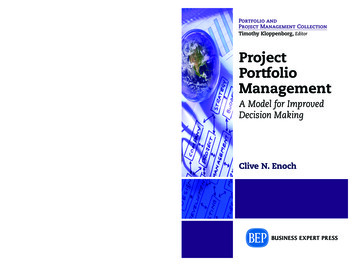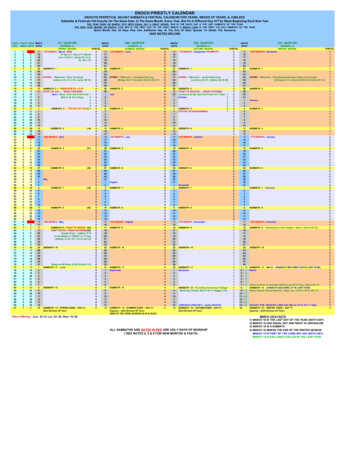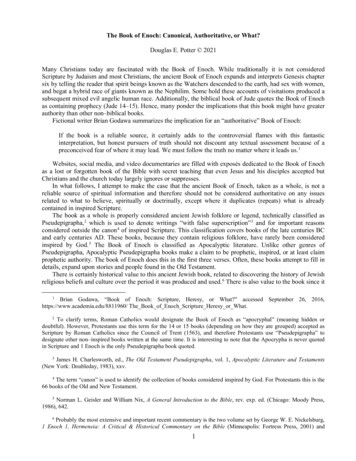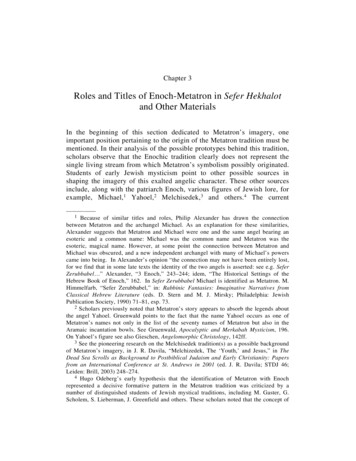
Transcription
Project Portfolio ManagementEBOOKS FORBUSINESS STUDENTSClive N. EnochA Model for Improved DecisionMakingCurriculum-oriented, borndigital books for advancedbusiness students, writtenby academic thoughtleaders who translate realworld business experienceinto course readings andreference materials forstudents expecting to tacklemanagement and leadershipchallenges during theirprofessional careers.Project portfolio management (PfM) is a c riticallyPOLICIES BUILTBY LIBRARIANS objectives and benefits. Unlimited simultaneoususage Unrestricted downloadingand printing Perpetual access for aone-time fee No platform ormaintenance fees Free MARC records No license to execute mechanism to determine the individual and c umulativeThe Digital Libraries are acomprehensive, cost-effectiveway to deliver practicaltreatments of importantbusiness issues to everystudent and faculty member.industries during this time. Clive holds a master ofin order to extract the maximum value from their project investments. Essentially, PfM can be defined asthe translation of strategy and organizational objectivesinto p rojects, programs, and o perations (portfoliocomponents); the allocation of resources to portfoliocomponents according to organizational priorities;alignment of components to one or more o rganizationalobjectives; and the management and control ofthese components in order to achieve o rganizationalcontribution of portfolio components to strategicobjectives so that the right decisions can be made regarding those components.Dr. Clive N. Enoch has been a practitioner of p roject,program, and portfolio management, as well as a manager of project and portfolio management officesover the past 20 years and has worked across m ultiplecommerce degree in information systems manage ment from the University of the Witwatersrand (WITS)in Johannesburg and a PhD in computer science fromthe University of South Africa (UNISA). His PhD thesisresulted in a model for decision making in project portfolio management and has contributed to the PMI’sfree trial, or to order, xpertpress.com/librariansThe Standard for Portfolio Management, third edition, as acore committee member.Portfolio andProject Management CollectionTimothy Kloppenborg, EditorISBN: 978-1-63157-270-8PROJECT PORTFOLIO MANAGEMENTThe focus of this book is aimed at providing aPortfolio andProject Management CollectionTimothy Kloppenborg, EditorProjectPortfolioManagement important discipline, which organizations must embrace portfolio management. Clive is passionate about projectFor further information, aENOCHTHE BUSINESSEXPERT PRESSDIGITAL LIBRARIESA Model for ImprovedDecision MakingClive N. Enoch
Project PortfolioManagement
Project PortfolioManagementA Model for ImprovedDecision MakingClive N. Enoch
Project Portfolio Management: A Model for Improved Decision MakingCopyright Business Expert Press, LLC, 2015.All rights reserved. No part of this publication may be reproduced,stored in a retrieval system, or transmitted in any form or by anymeans—electronic, mechanical, photocopy, recording, or any otherexcept for brief quotations, not to exceed 400 words, without the priorpermission of the publisher.First published in 2015 byBusiness Expert Press, LLC222 East 46th Street, New York, NY 10017www.businessexpertpress.comISBN-13: 978-1-63157-270-8 (paperback)ISBN-13: 978-1-63157-271-5 (e-book)Business Expert Press Portfolio and Project Management CollectionCollection ISSN: 2156-8189 (print)Collection ISSN: 2156-8200 (electronic)Cover and interior design by Exeter Premedia Services Private Ltd.,Chennai, IndiaFirst edition: 201510 9 8 7 6 5 4 3 2 1Printed in the United States of America.
AbstractProject portfolio management (PfM) is a critically important discipline,which organizations must embrace in order to extract the maximumvalue from their project investments. Essentially, PfM can be definedas the translation of strategy and organizational objectives into projects,programs, and operations (portfolio components); the allocation ofresources to portfolio components according to organizational priorities;alignment of components to one or more organizational objectives; andthe management and control of these components in order to achieveorganizational objectives and benefits.The interest and contribution to the body of knowledge in PfMhas been growing significantly in recent years, however, a particulararea of concern is the decision making, during the management of theportfolio, regarding which portfolio components to accelerate, suspend,or terminate. A lack of determining the individual and cumulativecontribution of portfolio components to strategic objectives leads topoorly informed decisions that negate the positive effect that PfM couldhave in an organization. The focus of this book is aimed at providing amechanism to determine the individual and cumulative contribution ofportfolio components to strategic objectives so that the right decisionscan be made regarding those components.Having the ability to determine the contributions of portfoliocomponents to strategic objectives affords decision makers the opportunity to conduct what-if scenarios, enabled through the use of dashboardsas a visualization technique, in order to test the impact of their decisionsbefore committing them. This ensures that the right decisions regardingthe project portfolio are made and that the maximum benefit regardingthe strategic objectives is achieved.This book is intended for executives, project and program directors,project portfolio managers, project office managers, and training providersin project, program, and PfM.Keywordscomplexity, decision making, multicriteria utility, organizational, projectportfolio management, systems
ContentsAcknowledgments ixChapter 1 Introduction 1Chapter 2A Model for Decision Making 7Chapter 3Extending the Model 35Chapter 4Using the Model 47Chapter 5Conclusion 75Appendix 1: Related Theories 81Notes 101References 105Index 109
AcknowledgmentsI would like to take this opportunity to thank:God, for blessing me in this endeavour and giving me the strength topersevere through this journey.My wife, Synthie, for her prayers, support, encouragement and foralways believing in me.My sons, Shaun and Carlin, for their support and understanding.My father, Stephen, and other family members for their support.My friend, Greg Wilby, for his contribution in challenging my thinking on various aspects.Professors Les Labuschagne and Tim Kloppenborg, for their guidance,encouragement and support.
CHAPTER 1IntroductionIntroductionProject portfolio management is concerned with managing groups ofprojects, programs, and operational activities (hereafter referred to asportfolio components) that compete for scarce resources and that are conducted to achieve strategic business objectives. Earlier l iterature relatedto project portfolio management focused attention on the selection andprioritization of projects and programs; however, merely choosing theright portfolio components is not enough as decisions made duringthe management of the portfolio could negate the very effort in settingup the portfolio. Instead, the focus needs to shift toward finding waysto ensure that the right decisions are made with regard to terminating,accelerating, or delaying portfolio components. This leads to portfolioand, ultimately, business success.Project portfolio management is by no means a solution to all anorganization’s problems; however, it is intended to enable organizationsto do more with less. As the world deals with the current financial crisis,it is more important now than in the past few decades for organizationsto ensure they are spending their money on the right project investments.This is reliant on influential stakeholders playing a crucial role in thechoices made when managing the portfolio.This chapter outlines the remainder of this book and includes thepositioning of project portfolio management in terms of its (i) role inthe management of project-related investments, as well as (ii) its role incontributing toward organizational success.Project Portfolio Management-OverviewMany authors are of the view that while project and program managementis traditionally focused on doing projects right, portfolio management
2PROJECT PORTFOLIO MANAGEMENTis focused on doing the right projects. The term portfolio is also associated with a collection of financial investment instruments, that is, stocksand bonds; however, this book does not attempt to address such typesof portfolios. Instead, the area of concern encompasses project portfoliomanagement and is hereafter referred to as PfM.PfM comprises a set of managed technology assets, process investments, human capital assets, and project investments that are allocatedto business strategies according to an optimal mix based on assumptionsabout future performance. The Project Management Institute (PMI)defines PfM in The Standard for Portfolio Management as “the coordinatedmanagement of one or more portfolios to achieve organizational strategies and objectives” and “includes interrelated organizational processesby which an organization evaluates, selects, prioritizes, and allocates itslimited internal resources to best accomplish organizational strategiesconsistent with its vision, mission, and values.” They further state that,“Portfolio management produces valuable information to support or alterorganizational strategies and investment decisions.”1The Office of Government Commerce (OGC) in the United Kingdomdefine PfM as “a co-ordinated collection of strategic processes anddecisions that together enable the most effective balance of organizationalchange and business as usual.”2A goal of PfM is to guide investment decisions to maximize value andminimize risk or uncertainty thus optimizing the organization’s returnon investment. PfM is an effective way to communicate value in businesslanguage. Value is achieved from balancing risk and reward and makingthe right decisions in this regard. The approach of the remainder of thisbook is based on this understanding of PfM.Project Portfolio ManagementThe Decision-Making ChallengeEarly approaches to PfM emphasized the categorizing of the landscapeof existing projects in organizations without paying much attention toportfolio management decision making. Ward and Peppard, for example,illustrated that categories such as strategic, operational, high potential,and support could be used as a means for facilitating agreement between
Introduction3senior management on the available and required portfolio of projects.3Individual projects could then be categorized according to their businesscontribution. This is an important step forward in the developing discipline of PfM; however, selecting the right projects upfront is meaninglessif the wrong decisions are taken later on in the PfM process.PfM improves organization success if the right decisions are madewhen managing the portfolio. Further, successful organizations have ashared reporting approach to channel information flows from component level to portfolio level. Such organizations share responsibility fordecisions at the portfolio level. The decision making at the portfolio levelis the key focus of this book, since enabling decision making is becomingincreasingly important given the economic downturn and renewed focuson corporate governance mentioned earlier. The selection of the rightportfolio components only goes part of the way to achieve success, butmaking the right decisions during the course of managing the p ortfoliowill contribute further to the success of the portfolio and, by extension,the success of the organization. Specifically, this book focuses on the process or approach that enables decision making with regard to determining which portfolio components to delay, accelerate, or terminate.When making decisions, consideration must be given to the contribution of portfolio components (strategic fit) to organizational objectives. An assessment of the contribution that portfolio components maketo organizational objectives will depend on an evaluation of multiplecriteria. Therefore, the problem statement that this book is focused onaddresses the following issue.When managing a project portfolio, an understanding of both theindividual and cumulative contribution of portfolio components toorganizational objectives and the likely impact of such decisions on theachievement of these objectives is important in decision making. Withoutthis understanding, the decisions regarding whether to delay, accelerate,or terminate portfolio components will be poor.Structure of the BookThe book consists of five chapters. Figure 1.1 provides a diagrammaticlayout of the book followed by a more detailed overview of each chapter.
4PROJECT PORTFOLIO MANAGEMENTChapter 1IntroductionChapter 2Decision-making modelChapter 4Illustrating how themodel would be usedChapter 3Extending the modelChapter 5ConclusionAppendix 1Related theoriesFigure 1.1 Chapter layoutChapter 1 provides the introduction, motivation for the book,problem statement, and layout of the book.Chapter 2 discusses the complex relationship between portfolio components and organizational objectives and presents the model, which isdeveloped to address the problem of determining the cumulative contribution of portfolio components to organizational objectives. This is doneby taking as input the qualitative evaluations of multiple criteria for eachportfolio component and producing a single quantitative value representing the cumulative contribution.Chapter 3 extends the conceptual model presented in Chapter 2.The fundamental principles presented in Chapter 2 are used in this chapter, but instead of viewing the problem from the perspective of the contribution of multiple components to individual objectives, Chapter 3 looksat the contribution of a single component to multiple objectives. Thischapter illustrates how the concepts presented in Chapter 2 can be usedin a different way.Chapter 4 looks at illustrating how the model could be used usingactual portfolio components and organizational objectives from a participating organization. The illustration of the model in this chaptershows the mechanics of the model and confirms how the impact of decisions regarding portfolio components can be quantified.
Introduction5Chapter 5 provides a summary and makes final recommendations forthe application of the model presented in this book.Appendix 1 presents a review of the literature on PfM and discusses thedefinition for PfM. It also describes five theories that provide a theoreticalfoundation for PfM. The theories described are Modern Portfolio Theory,Multi-Criteria Utility Theory, Organization Theory, Systems Theory, andComplexity Theory.ConclusionThis chapter provides an overview of PfM and describes thedecision-making challenge, which is addressed by the model presentedlater in this book. This chapter further outlines the structure for the restof the book.PfM is intended to guide investment decisions such that value ismaximized, risk or uncertainty is minimized, and organizational success is achieved. The global economic crisis, prevalent at the time ofconducting the research that lead to this book, forced organizationsto carefully consider their spending in terms of project-related investments. PfM is a mechanism that can address this issue provided thedecision makers have a means to evaluate component contribution tostrategy. The requirement for organizations to comply with legislative,regulatory, and governance requirements—as well as the factors listedearlier—means that the decisions taken during the management of theportfolio must be well informed so that the objectives of PfM can beachieved.To ensure that decisions are well informed, or to put it differently,to improve PfM decision making, it is necessary to show how decisionswill impact the success of the portfolio and ultimately the success of theorganization. Organizational success is measured by the achievementof objectives, and portfolio components are executed to deliver organizational objectives. It can be deduced that finding a way to show thecontribution of portfolio components to the organizational objectiveswill enable decision makers to test the impact of their decisions regarding portfolio components on the portfolio before committing them.This will enable decisions to have a minimum impact on the portfolioand organization while achieving maximum effect.
CHAPTER 2A Model for DecisionMakingIntroductionThis chapter discusses a decision-making model for portfolio management(PfM) and is based on a response to findings from an investigationinto the practice of PfM in various organizations. The key finding thatmotivated this chapter and the need for a model for decision making inPfM was the fact that many organizations lacked a clear approach whendeciding which portfolio components to terminate, fast track, or put onhold during the course of managing the portfolio. Some organizationstake the easy route and trim budgets across all portfolio components by aspecified percentage in order to make the affordability constraints. Otherorganizations cancel portfolio components on the basis that they havenot commenced yet. Most, if not all, reasons are related to short-termaffordability rather than an understanding on the longer-term strategicconsequence of these decisions.In order to understand the implications of decision making in PfM,we need to (a) establish the relationship between organizational objectives and portfolio components, (b) describe the process for evaluatingthe individual and cumulative contribution of portfolio components toorganizational objectives, and (c) describe the value and utility of themodel in improving PfM decision making.Later, motivating the need for a model, describing the objectives ofthe model, and the considerations that gave rise to the development ofthe model are discussed. This is followed by an exploration into the relationship between organizational objectives and portfolio componentsand a description of the complex nature of this relationship. A discussionon the model itself is then presented. The inputs, processes, and outputs
8PROJECT PORTFOLIO MANAGEMENTof the model are explained, showing how the qualitative evaluation ofcomponents can be converted into a quantitative value that representsthe contribution to organizational objectives. The chapter concludes witha discussion on the value and utility of the model with regard to PfMdecision making in organizations.Motivation for a ModelEarlier approaches to PfM focused on the selection and categorization ofprojects and had less to do with the management and decision-makingprocesses involved in managing the portfolio. The focus in the literaturebegan to shift later, however, toward aligning IT and business strategy,1managing IT projects like an investment portfolio,2 and using IT PfM tounlock the business value of technology.3Subsequently, authors have given increasing focus to the role of single project management in achieving portfolio efficiency;4 alignment ofthe project portfolio to corporate strategy, vertical integration, and valuecreation through PfM;5 the translation of strategy into programs andprojects, organization performance, and the role of the project/programmanagement office;6 project portfolio control and performance;7 and theinfluence of business strategy on PfM and its success.8 Most recently, thethird edition of The Standard for Portfolio Management9 introduced threenew knowledge areas (portfolio strategic management, portfolio performance management, and portfolio communication management) thatexpand on the previous edition significantly. This illustrates the increasedemphasis on strategic alignment and portfolio performance specifically.An understanding of the purpose or objective of PfM is important:“The objective of portfolio management is to determine the optimal mixand sequencing of proposed projects to best achieve the organizationalstrategy and objectives.”10 They add that managing the performance ofa portfolio is critical in closing the gap between organizational strategyand the fulfillment of that strategy. This implies that successfully managed portfolios (and hence successful projects, programs, and operational activities) are measured by the achievement of organizationalstrategy and objectives (hereafter referred to collectively as organizationalobjectives). A key consideration, therefore, is the contribution made by
A Model for Decision Making9projects, programs, and operational activities (portfolio components)toward achieving the organizational objectives. The author had to consider the quantitative and qualitative measures of assessment of portfoliocomponents to determine the contribution of portfolio components toorganizational objectives. This enabled a form of reasoning that would besuitable to model such a system.The factors that served as input toward the development of the modelwere:1. The observation from an earlier investigation into the practice ofPfM that decision making regarding the management of portfolioswas poor.2. The objective of PfM, which is the determination and managementof the optimal mix of portfolio components toward achieving theorganizational objectives.3. The need to understand the relationship between portfolio components and organizational objectives in order to understand theimpact of decisions regarding portfolio components on organizational objectives.4. The consideration of qualitative and quantitative ways of determining portfolio component contributions to organizational objectives.5. The application of the theories related to PfM (refer to Appendix 1).The objective of the decision-making model presented in thischapter is to qualitatively evaluate portfolio components using multiplecriteria to determine the individual and cumulative contribution ofthese components to organizational objectives so that the right PfMdecisions regarding which components to stop, progress, or terminatecan be made.Relationship Between Portfolio Componentsand Organizational ObjectivesHaving a well-defined strategy and organizational objectives without theability to execute them, or having efficient and effective operations without a strategy or organizational objectives limits the success organizations
10PROJECT PORTFOLIO MANAGEMENTcould have. This notion is supported by Drs Kaplan and Norton whostate the following:A visionary strategy that is not linked to excellent operationaland governance processes cannot be implemented. Conversely,operational excellence may lower costs, improve quality, andreduce process and lead times; but without a strategy’s vision andguidance, a company is not likely to enjoy sustainable success.11This emphasizes the need not only to link strategy and execution, butalso to be able to assess the degree of contribution the components maketoward achieving the strategy.According to the Project Management Institute (PMI), organizationsbuild strategy to define how their vision will be achieved. The visionis enabled by the mission, which directs the execution of the strategy.The organizational strategy is a result of the strategic planning cycle, wherethe vision and mission are translated into a strategic plan. The strategicplan is subdivided into a set of initiatives that are influenced by marketdynamics, customer and partner requests, shareholders, governmentregulations, and competitor plans and actions. These initiatives establishportfolio components that, through their execution, ultimately achievethe organizational objectives. Linking the organization’s objectivesdirectly to the portfolio components reveals that there is a many-to-manyrelationship between objectives and components.This relationship can be illustrated as in Figure 2.1. Each portfoliocomponent (PC) contributes to one or more objectives. For example,PC1 could contribute to partly achieving objectives 1, 3, and (n), whilethe remainder of objective 1 is achieved through the execution of PC3.PC2 could contribute to fully achieving objective 2, and objective (n)could be achieved by components 1 and (m). The degree of contributionof each component varies one from the other.An alternate depiction of this relationship is given in Table 2.1.In addition to mapping the components to their related objectives, itis also important to understand the relationships between portfolio components. For example, while PC1 and PC3 contribute to the achievementof objective 1, they do not necessarily have to be related to each other in
A Model for Decision Making11MISSIONVISIONPORTFOLIOCOMPONENT 1OBJECTIVE1PORTFOLIOCOMPONENT 2OBJECTIVE2PORTFOLIOCOMPONENT 3OBJECTIVE3PORTFOLIOCOMPONENT 4OBJECTIVE4PORTFOLIOCOMPONENT 5OBJECTIVE(n)PORTFOLIOCOMPONENT 6PORTFOLIOCOMPONENT (m)Figure 2.1 Many-to-many relationship between organizationalobjectives and portfolio componentsSource: Adapted from Enoch and Labuschagne.12Table 2.1 Relationship between organizational objectives and portfoliocomponentsVisionObjective Objective Objective Objective Objective1234(n)Portfolio Component 1aPortfolioPortfolio Component 2Portfolio Component 3Portfolio Component 4dcbePortfolio Component 5Portfolio Component 6Portfolio Component (m)igfhjSource: Enoch and Labuschagne.13any other way. They could be singular, independent projects managed bydifferent teams and not dependent on each other through deliverables orresources. On the other hand, for objective 3, PC1, PC4, and PC6 couldbe run as a program where all components are related to each other and
12PROJECT PORTFOLIO MANAGEMENThave interdependency through, for instance, deliverables and/or resources.Each component contributes to objectives to varying degrees. For example,the degree of contribution of PC1 to objective 1 is represented by (a), andthe degree of contribution of PC3 to objective 1 is represented by (b).The degree of contribution of these two components to objective 1 is notequal. Additionally, PC1 also contributes to objectives 3 and (n) and thedegree of contribution to each of these objectives (including objective 1) isrepresented by (a), (d), and (i). The degree of contribution of a single component (PC1) to each of the three objectives is not equal. The degrees ofcontribution, represented by the letters (a) to (j) in Table 2.1, vary for eachcomponent-to-objective relationship. The challenge is in understandingthe degree of contribution of each component to each objective, as wellas the collective contribution of many components to a single objective.Understanding the degrees of contribution of portfolio componentsto the achievement of organizational objectives also aids the organizationin understanding the impact of decisions made in relation to those components. When certain constraints are applied to the portfolio, such asa reduction in budget or a change in strategy, the organization needs amechanism to aid management in decision making regarding rebalancing the portfolio. For example, if there is a reduction in the availablefunds for portfolio components, the organization can choose to stop orslow down components that make a low contribution to organizationalobjectives. Alternatively, a change in strategy may reprioritize certainobjectives, resulting in the fast tracking of associated components thatmake a medium or high contribution. Low, medium, and high refer to thequalitative assessment of the degree of contribution of components.In addition to the preceding, assessing the degree of contributionof portfolio components to objectives will also achieve the benefit of determining gaps in the portfolio. If the combined contribution of components 5 and 6 to objective 4 is determined to be less than 1, it may benecessary for the organization to consider additional portfolio components to close the gap and achieve the objective fully.The evaluation of portfolio component contribution is done subjectively. Linguistic values such as low, medium, or high are used to describethe degree of contribution. In order to effectively compare components,however, quantitative values would need to be used. The challenge is in
A Model for Decision Making13converting the qualitative assessments into quantitative values. In addition, a mechanism for dealing with the cumulative contribution of portfolio components is required. To address these requirements, a techniqueis required for the model that can deal with converting qualitative valuesinto quantitative values while simultaneously computing the cumulativecontribution of multiple components to single objectives. Following areview of various techniques, it was determined that Fuzzy Logic wouldbe a suitable technique to use in the model as it addresses the challengeof converting qualitative assessments into quantitative values. The use ofFuzzy Logic when developing the model is discussed in more detail in theupcoming paragraphs.ModelThe following discussion gets slightly technical as it goes into how themodel uses Fuzzy Logic to achieve its outcomes. However, the authorbriefly desc
project portfolio managers, project office managers, and training providers in project, program, and PfM. . shared reporting approach to channel information flows from compo-nent level to portfolio level. Such organizations share responsibility for decisions at the portfolio level. The decision making at the portfolio level











